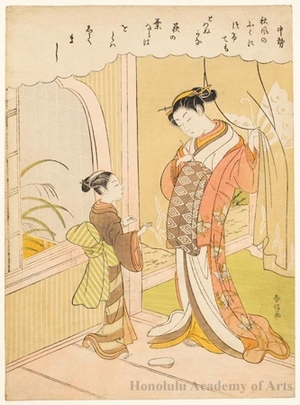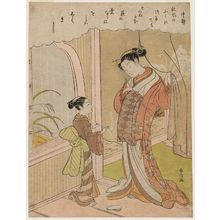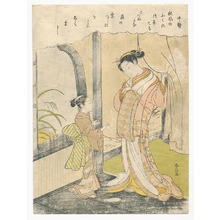鈴木春信による浮世絵「Nakatsukasa」
作者:鈴木春信
作品名:Nakatsukasa
制作年:c. 1767 - 1768
詳細:詳細情報...
情報源:ホノルル美術館
浮世絵(全 5,476 件)を表示...
説明:
With narrow eyes, a nose line leading to pursed lips and tiny facial features on a delicately slim figure, Harunobu’s beauties dominated the Meiwa era(1764-1772). A kamuro (child trainee) is delivering a client’s letter to the home of a courtesan. The meaning of the classic poem has been parodied into a lament over the client’s regret at not visiting. Akikaze no/fuku ni tsukete mo/towanu kana Haginoha naraba/oto wa shitemashi “ The autumn wind has begun to blow and still you do not visit/ Even the bush clover is knocking!” (Tadashi Kobayashi, Edo Beauties in Ukiyo-e, 1994) With narrow eyes, a nose line leading to pursed lips, and tiny facial features on a slim figure, Harunobu’s beauties dominated the Meiwa era (1764-1772). The delicate ideal of this time is seen in the balance and harmony of subtleness. The courtesan Nakatsukasa wears a kimono with butterfly patterns which are symbols of longevity. The entrance curtain (noren) also has a butterfly motif. A kamuro (child trainee) with a vertically tied sash is delivering a client’s letter to Nakatsukasa’s home. One of the courtesan’s sandals still left on the floor suggests that she rushed out, eagerly awaiting the message from her lover. The meaning of the classic poem at the top has been parodied into a lament over the client’s regret at not visiting: Akikaze no/fuku ni tsukete mo/towanu kana Haginoha naraba/oto wa shitemashi “ The autumn wind has begun to blow and still you do not visit/ Even the bush clover is knocking!” (from "VOGUE in Japan: Edo Fashion through Japanese prints"exhibition 07/30-)


